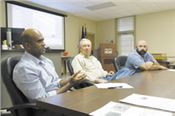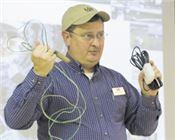|
Workshop Highlights Importance Of Timely, Efficient Irrigation
BOSSIER CITY, LA.
Irrigation often is the key to a successful crop in Louisiana. But it can be difficult for farmers to time irrigation events so they are most beneficial and to apply the water in an efficient way.
Those were among the topics discussed on Jan. 17 during the first in the LSU AgCenter’s second annual series of workshops on sustainable irrigation practices. The event, held at the LSU AgCenter Red River Research Station in Bossier City, featured presentations by AgCenter and Natural Resources Conservation Service personnel as well as panel discussions that included farmers.
Two more workshops will be held: on Jan. 25 in Winnsboro and on Feb. 14 in Marksville. Farmers, consultants and others who work in agriculture are urged to attend. They can register online at lsuagcenterwater.eventbrite.com.
To achieve maximum yields, corn, soybeans and grain sorghum need at least 20 inches of water, AgCenter corn and cotton specialist Dan Fromme told attendees of the Bossier City meeting.
Farmers must time irrigation to fill in gaps between rains and provide plants enough water at critical growth stages. Corn needs the most water at the tasseling and silking stages, and soybeans at the flower, full-bloom and pod-filling stages, Fromme said.
Farmers also should take into account how much water their soil holds, which varies by soil type and can be affected if there are compaction issues, Fromme said.
AgCenter engineer Stacia Davis said agricultural irrigation and overall water use has increased in recent years in Louisiana. In 2014, the state used 9.3 billion gallons of water, about half of which was used for power generation, she said.
Louisiana’s groundwater aquifers – which can take decades and centuries to be replenished – are facing pollution from chemicals, saltwater intrusion and low water levels. That is concerning, Davis said, because groundwater is the most common source of irrigation water.
“We have increased our use but have not changed where we’re drawing it from,” she said, adding that the state needs to make better use of its abundant surface water.
AgCenter water quality specialist Changyoon Jeong told about his work monitoring nutrient content of water from Red Bayou, an NRCS project that pumps water from the Red River to a bayou so farmers can use it instead of groundwater to irrigate. He also discussed his research on tailwater recovery, a system that captures irrigation runoff and rainwater so it can be recycled.
AgCenter agronomist Syam Dodla said most Louisiana farmers irrigate by flooding furrows. That practice is only 40 to 70 percent efficient, he said.
“If efficiency is low, producers are going to lose the fertile top soil through runoff and nutrients through runoff and leaching. Additionally, excessive water removal makes the groundwater more saline as the season progresses,” he said.
Irrigating every other row uses up to 30 percent less water without a yield penalty, Dodla said. The practice works best in heavy soils.
NRCS agronomist Chris Coreil said his agency can provide financial assistance to farmers who want to try new technologies and implement conservation practices, such as planting winter cover crops to improve soil health. Having healthy soil is important, he said, because it promotes good water quality, increased infiltration and water holding capacity, and increases drought tolerance.
Although irrigation water management is only part of a conservation plan, it is an important consideration for many reasons, said Louisiana Master Farmer Program coordinator Ernest Girouard.
Today’s farmers are tasked with feeding a growing world population. But the amount of available water is decreasing, Girouard said, with agriculture using between 60 and 70 percent of the global supply.
Bruce Garner, AgCenter agent in West Carroll Parish, stressed the difference between watering and irrigating.
“Watering is going out and turning the pump on and not bringing any tools,” he said.
Computerized hole-selection software can help farmers decide how many and what size holes to punch in poly pipe. Two programs – PHAUCET and Pipe Planner – are available for free.
Soil moisture sensors collect data that can help farmers determine if more water is needed. Davis, who has tested several types of sensors, said each model has different strengths and limitations.
Sensor data by itself should not be the basis for an irrigation decision, Davis said.
“You can’t replace knowledge of what the crop does, what the soil does and knowing your field,” she said. “But these technologies can help you make a decision about irrigating if you’re on the edge.”
The AgCenter is developing two electronic tools to help farmers irrigate better. One is a spreadsheet that uses information that farmers input about their fields, crops and climatic factors to determine when subsequent irrigation events are needed.
The AgCenter also is working on an app for smartphones, tablets and computers that will help farmers calculate cost savings for various irrigation equipment investments. AgCenter economist Naveen Adusumilli said the app is expected to be ready in a few weeks. ∆

From left, LSU AgCenter economist Naveen Adusumilli, farmer Sonny Kirby and Natural Resources
Conservation Service district conservationist Brian Baiamonte participate in a panel discussion
about irrigation during a workshop held Jan. 17 at the LSU AgCenter Red River Research Station in Bossier City.
Photos by Olivia McClure/LSU AgCenter

Bruce Garner, LSU AgCenter agent in West Carroll Parish, discusses two types of soil
moisture sensors during a sustainable irrigation workshop held Jan. 17 at the LSU
AgCenter Red River Research Station in Bossier City.
|
|